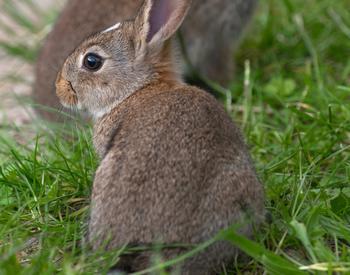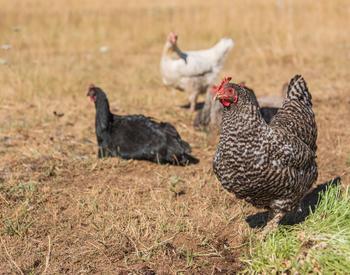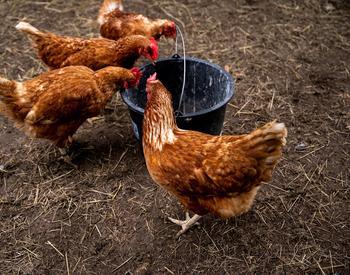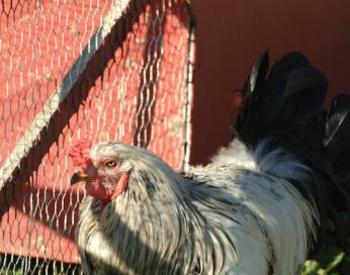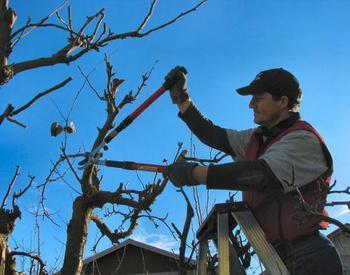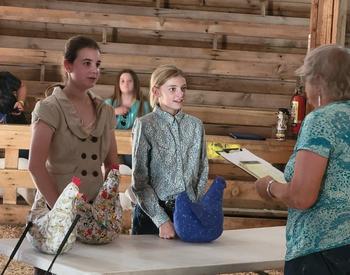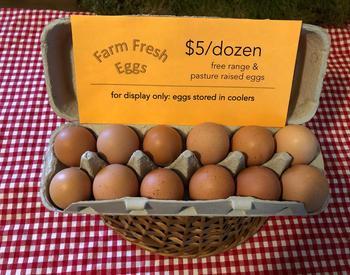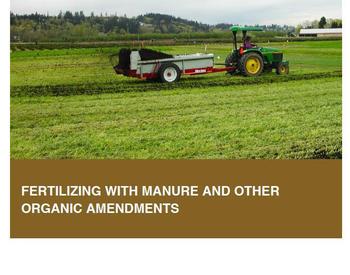NOTE: This resource is part one of an informational series. View all resources in the series.
The purpose of this resource is to serve as a genetics guide for rabbit enthusiasts. Rabbits are bred for 4-H projects, hobby farms, as personal pets, and for other uses such as meat and fiber production. Yet, current resources about coat color genetics are either too technical and complicated, not easy to access, or not available publicly. Let's fix that!
In this article, we aim to provide:
- An introduction of rabbit genetics and key concepts.
- A glossary of genetics terms.
- A discussion of how genes work together to control coat color and patterning in rabbits.
NOTE: In this collection of articles we will be focusing on the 7 known genes that have been confirmed to affect rabbit coat color. There is still much unknown about the rabbit genome and there are many genes whose functions have not yet been identified or clarified.
Introduction
Genetics is the branch of biology that focuses on the study of genes and heredity. The study of genetics is essential to understanding what to expect in the offspring of particular pairs of parents. Genetic information is stored in the DNA, and the composition of those genes plays a large role in determining what we see and can measure when we look at an individual rabbit.
Words and concepts to know
- Phenotype: An observable or measurable trait of an individual.
- Gene: The basic unit of heredity that consists of a DNA sequence at a specific location on a chromosome.
- Allele: Alternative form of gene that differs in DNA sequence; synonymous with genetic variant.
- Genotype: A list of the alleles present at a particular gene of interest or in the individual organism as a whole.
- Heterozygosity: Having two different alleles for a particular gene.
- Homozygosity: Having two identical alleles for a particular gene.
- Dominance: The expression of alleles of a single, heterozygous gene where one allele has more effect on the phenotype than the other.
- Wild-type: Refers to the "original" allele or phenotype, meaning prior to domestication or before a mutation created a different allele.
- Punnett square: A grid used to determine the potential offspring of a specific mating pair. This form of prediction can be used to determine the genotype ratio of the offspring. A simple Punnett square is a nine-square grid (see Table 1), but can increase to a much larger size depending on the pairings and the number of genes under consideration.
Let's review the terminology using a real-life example. In rabbits, the B gene controls the color base of the coat. The B gene has two alleles: B and b. The B allele is considered the wild-type allele: it codes for black color.The b allele codes for chocolate (brown) color base. Assuming the rest of a rabbit’s coat color genes indicate a solid, dark color phenotype and that rabbit has genotype BB at the B gene, it will be black. A rabbit that is homozygous bb will be chocolate. A rabbit that is heterozygous Bb will be black.
Why? Because the B allele is dominant over the recessive b allele, so a rabbit with genotype Bb will have the same coat color phenotype as a rabbit with the dominant homozygous genotype BB. View this relationship in a Punnett square.
How genes work
Coat color in rabbits is controlled by several genes.
Not all genes have been identified, and much is still unknown about the rabbit genome. There may even be as yet unidentified alleles for the known genes. We will learn more about specific coat color genes in the next article (part two).
Additivity
Some genes have alleles that act in an additive fashion. That means that, unlike the B gene example above, where the B allele is dominant to the b allele, a heterozygote phenotype would be about halfway between the two homozygote phenotypes.
Genes with alleles in additive relationships play large roles in what we call quantitative traits, those that are 'measurable in numbers'. An example of a quantitative trait is a rabbit's body weight at 10 weeks. The weight of a rabbit depends on its genetics and contributions from its environment (such as feed quality and how many littermates it has).
Let’s use a made-up example and say gene W influences body weight. For a group of 10-week-old rabbits, let's assume all the environmental factors are exactly equal, and all of the other genes that contribute to body weight are equal. Alleles W and w have an additive relationship. In this example:
- A rabbit with genotype ww weighs 1 ounce less than the average 10-week-old rabbit.
- A Ww rabbit weighs the same as the average.
- A WW rabbit weighs 1 ounce more than the average rabbit.
All the alleles present in the genotypes can be observed in the phenotypes. They appear additively: with each additional W allele, the rabbit is one ounce heavier. We can view the inheritance of this relationship in a Punnett square (Table 1, below).
| W | w | |
|---|---|---|
| W | WW Homozygote High |
Ww Heterozygote Average |
| w | Ww Heterozygote Average |
ww Homozygote Low |
Dominance
We’ve seen a bit about how dominant-recessive alleles relationships operate above with the B gene. That case is one of complete dominance, where the heterozygote (i.e., Bb) has the same phenotype as the homozygous dominant allele genotype (BB). We can fairly easily observe dominance in qualitative traits, which tend to be categorical, unlike quantitative traits. Coat color is a qualitative trait. Fur type (angora, standard, rex, etc.) is also a qualitative trait.
Imagine we have a mating pair of a male heterozygote black rabbit (Bb) and a female homozygote black rabbit (BB), what will the offspring be? The genotypes of the offspring will be based off of the genotypes of both parents. During conception, the sperm will carry a random half of the male genome and the egg will carry a random half of the female genome. This means that the sperm will only have one of the male’s alleles and the egg will have one of female’s alleles
A Punnett square can be used to determine the proportions of each genotype expected in the offspring. In the cross of Bb x BB, there is a 50% chance that the offspring with be homozygous black (BB) and a 50% chance the offspring will be heterozygous black (Bb). We can view this relationship in Table 2.
| B | b | |
|---|---|---|
| B | BB Homozygote Black |
Bb Heterozygote Black |
| B | BB Homozygote Black |
Bb Heterozygote Black |
If, however, we have a mating pair consisting of a male heterozygote black rabbit (Bb) and a female heterozygote black rabbit (Bb), what will the expected offspring proportions be? In this cross, there is a 25% chance that the offspring will be homozygous black (BB), 50% chance that the offspring will be heterozygous black (Bb), and 25% chance that the offspring will be homozygous chocolate (bb). See Table 3.
A cross of two heterozygote parents shifts the ratio of offspring (compared to Table 2), because of dominance and the alleles that each parent can provide.
| B | b | |
|---|---|---|
| B | BB Homozygote Black |
Bb Heterozygote Black |
| b | Bb Heterozygote Black |
bb Homozygote Chocolate |
Epistasis
Now that we have covered dominance, let’s expand that idea to epistasis. Epistasis is when the phenotypic expression of the genotype at one gene is dependent on the genotype at one or more other genes. It’s a little bit like dominance, but instead of the interaction happening between alleles at one gene, the interaction is between specific genotypes of different genes. For example, the E gene can interact with the B gene to change the color base of the coat.
The E gene controls the extension of dark pigment in the coat color. Two alleles of the E gene are E and e. The E allele codes for normal extension of dark pigment, meaning that the rabbit will appear as expected with the B genotype. The e allele codes for no extension of dark pigment. When homozygous, the e allele (genotype ee) only allows the production of yellow or red pigments over the back (no black or brown pigments). So, the genotype at the E gene can affect the expected outcome of the B gene; genotype ee is epistatic to the B genotypes. A rabbit with an ee genotype would appear red/orange/fawn regardless of what is coded by the B gene.
We will learn more how the coat color genes interact to affect phenotype in part 2.
When we are considering two genes, the Punnett square gets bigger, with potentially more outcomes. Table 4 shows the expected genotypic and phenotypic proportions of the offspring from a mating of a bbEe parent and a BbEe parent.
| BE | Be | bE | be | |
|---|---|---|---|---|
| bE | BbEE Black |
BbEe Black |
bbEE Chocolate |
bbEe Chocolate |
| be | BbEe Black |
Bbee Fawn |
bbEe Chocolate |
bbee Fawn |
| bE | BbEE Black |
BbEe Black |
bbEE Chocolate |
bbEe Chocolate |
| be | BbEe Black |
Bbee Fawn |
bbEe Chocolate |
bbee Fawn |
